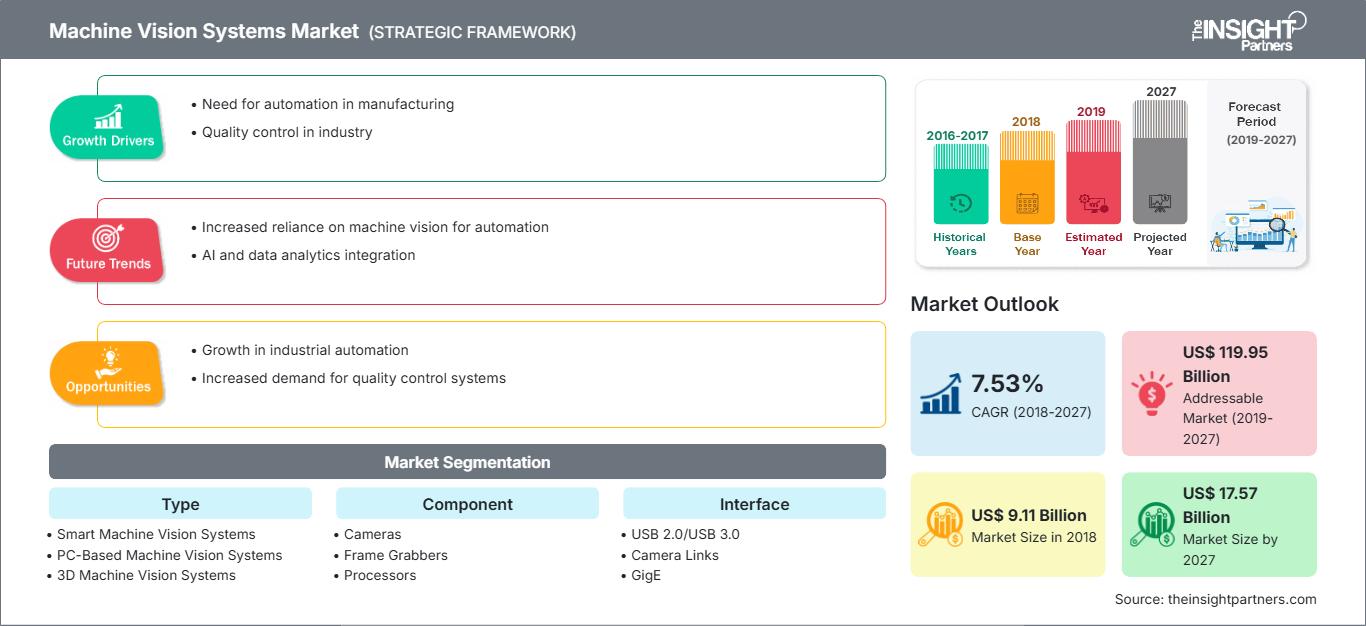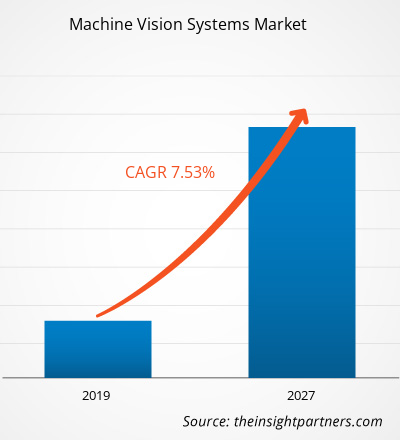マシンビジョンシステム市場は2025年に203.7億米ドルと評価され、2026年から2034年の間に12.80%のCAGRを記録し、2034年までに534億米ドルに達すると予測されています。
マシンビジョンシステム市場分析
マシンビジョンシステム市場は、産業分野における自動化の進展、目視検査・測定の需要増加、そして業務効率向上のニーズを背景に、成長が見込まれています。カメラ、ソフトウェア、光学系、センサーで構成されるこれらのシステムは、製造業および関連分野における検出、識別、測定、検査業務を可能にします。ロボット工学、インダストリー4.0への統合、そしてビジョン誘導システムへの注目の高まりも、市場拡大の原動力となっています。
マシンビジョンシステム市場の概要
マシンビジョンシステム(MVS)は、カメラ、照明、光学系、そして処理アルゴリズムを活用し、産業オペレーションにおける人間の視覚タスクを再現するインテリジェントな自動化ソリューションです。これらのシステムは、検査の自動化、ロボットの誘導、測定・検証タスクの実現、そして手作業への依存度の低減を実現することで、オペレーションを効率化します。MVSソリューションは、製造、自動車、エレクトロニクスなどの分野において、スループット、精度、そして品質基準への準拠を向上させる上で不可欠な存在になりつつあります。
要件に合わせてレポートをカスタマイズ
このレポートの一部、国レベルの分析、Excelデータパックなど、あらゆるレポートを無料でカスタマイズできます。また、スタートアップや大学向けのお得なオファーや割引もご利用いただけます。
マシンビジョンシステム市場:戦略的洞察

-
このレポートの主要な市場動向を入手してください。この無料サンプルには、市場動向から見積もりや予測に至るまでのデータ分析が含まれます。
マシンビジョンシステム市場の推進要因と機会
市場の推進要因:
- 製造業において、高品質な製品検査と生産サイクルの高速化のニーズが高まっています。
- 自動車やエレクトロニクスなどの業界では、ロボット工学やビジョンガイドによる自動化の導入が増加しています。
- スマート ファクトリー、自動化、産業のデジタル化をサポートする政府の取り組みと投資。
市場機会:
- アジア太平洋地域など、産業オートメーションが勢いを増している新興市場への進出。
- リアルタイム分析、機械学習、3D ビジョン システムを統合して、より複雑な検査やロボット アプリケーションを実現します。
マシンビジョンシステム市場セグメンテーション分析
タイプ別:
- スマートマシンビジョンシステム
- PCベースのマシンビジョンシステム
- 3Dマシンビジョンシステム
コンポーネント別:
- カメラ
- フレームグラバー
- プロセッサ
- 照明と光学
- ビジョンソフトウェア
- ビジョンセンサーおよびその他
インターフェース別:
- USB 2.0 / USB 3.0
- カメラリンク
- ギガビットイーサネット
- CoaXPress
最終用途産業別:
- 自動車
- エレクトロニクスおよび半導体
- 食品・飲料
- 医薬品
- ロジスティクス
地理別:
- 北米
- ヨーロッパ
- アジア太平洋
- 南米と中央アメリカ
- 中東・アフリカ
マシンビジョンシステム市場の地域別分析
マシンビジョンシステム市場を予測期間を通して左右する地域的な動向と要因については、The Insight Partnersのアナリストが詳細に解説しています。このセクションでは、北米、ヨーロッパ、アジア太平洋、中東・アフリカ、中南米におけるマシンビジョンシステム市場のセグメントと地域についても解説します。
マシンビジョンシステム市場レポートの範囲
| レポート属性 | 詳細 |
|---|---|
| 2025年の市場規模 | 203億7000万米ドル |
| 2034年までの市場規模 | 534億米ドル |
| 世界のCAGR(2026年~2034年) | 12.80% |
| 履歴データ | 2021-2024 |
| 予測期間 | 2026~2034年 |
| 対象セグメント |
タイプ別
|
| 対象地域と国 |
北米
|
| 市場リーダーと主要企業の概要 |
|
マシンビジョンシステム市場のプレーヤー密度:ビジネスダイナミクスへの影響を理解する
マシンビジョンシステム市場は、消費者の嗜好の変化、技術の進歩、製品メリットへの認知度の向上といった要因によるエンドユーザー需要の増加に牽引され、急速に成長しています。需要の増加に伴い、企業は製品ラインナップの拡充、消費者ニーズへの対応のためのイノベーション、そして新たなトレンドの活用を進めており、これが市場の成長をさらに加速させています。

- マシンビジョンシステム市場のトップキープレーヤーの概要を入手
マシンビジョンシステム市場シェアの地域別分析
北米
- 高度な製造インフラストラクチャ、自動化の早期導入、ビジョン システムにより、大きなシェアを獲得しています。
- トレンド: 自動車業界およびエレクトロニクス業界で、視覚誘導ロボットやスマートカメラの使用が増加しています。
ヨーロッパ
- 自動車業界とエレクトロニクス業界全体にわたって、官民両部門が工場の自動化と標準遵守を強力に推進しています。
- トレンド: 相互運用可能なビジョン システムの採用と国境を越えた製造の最適化。
アジア太平洋
- 最も急速に成長している地域は、製造拠点の拡大、産業オートメーションの増加、ビジョンシステムへの投資の増加によるものです。
- トレンド: 検査、電子機器製造、パッケージング、自動車業界で中国、インド、東南アジアでの急速な普及。
南米と中央アメリカ
- コスト効率の高いビジョン検査システムと工場自動化の需要が高まっている新興市場。
- トレンド: 小規模/中規模の製造業者が品質管理のためにモジュール式ビジョン システムを導入しています。
中東・アフリカ
- インフラ投資と、製造、石油・ガス、物流における自動化の増加を伴う発展途上の地域。
- トレンド: 新しい製造拠点におけるビジョン対応検査とロボットの導入。
マシンビジョンシステム市場のプレーヤー密度:ビジネスダイナミクスへの影響を理解する
マシンビジョンシステム市場には、世界的な大手企業と多数の地域専門企業が参入しており、競争が激しく、技術集約型となっています。主要ベンダーは、以下の方法で差別化を図っています。
- 3D ビジョン、AI、スマート カメラ モジュールの高度な統合。
- 小規模メーカーから大規模メーカーまで、あらゆるニーズに応えるスケーラブルなソリューション。
- ロボット工学、自動化、ソフトウェア プロバイダーと提携して、エンドツーエンドのビジョン主導型ソリューションを提供します。
マシンビジョンシステム市場で事業を展開している主要企業は次のとおりです。
- バスラーAG
- コグネックス株式会社
- データロジックSpA
- FLIRシステムズ株式会社
- IDSイメージング開発システムズ株式会社
- イスラビジョンAG
- キーエンス株式会社
- オムニビジョンテクノロジーズ株式会社
- オムロンマイクロスキャンシステムズ株式会社
- 東芝テリー株式会社
調査の過程で分析した他の企業:
- マイクロスキャンシステムズ株式会社
- ナショナルインスツルメンツ社
- ソニー株式会社
- テレダイン・テクノロジーズ・インコーポレーテッド
- アライドビジョンテクノロジーズGmbH
- JAI A/S
- ジックAG
- バウマー・ホールディングAG
- ビジョン・コンポーネンツ社
- トルディベルAS
マシンビジョンシステム市場のニュースと最近の動向
- プレスリリースによれば、マシンビジョンシステム市場は2027年までに175億7000万米ドル(基準年2018年)に達すると予想されています。
- 市場では、自動車、エレクトロニクスおよび半導体、物流の各分野で導入が進むスマートマシンビジョンシステムと3Dマシンビジョンシステムの大きな成長見通しが見られました。
- 主要企業は、AI、3Dイメージング、ロボットメーカーとの提携を通じて機能を拡張し、検査および自動化タスクを強化しています。
マシンビジョンシステム市場レポートの対象範囲と成果物
The Insight Partnersによる「マシンビジョンシステム市場 – グローバル分析と予測(2021~2034年)」レポートでは、以下の情報を提供しています。
- 調査対象となるすべての主要セグメントにわたる世界、地域、国レベルでの市場規模と予測。
- 推進要因、制約、機会などの市場の動向と動向。
- 詳細な PEST および SWOT 分析。
- 主要な市場動向、規制の枠組み、主要プレーヤー、最近の動向を網羅した分析。
- 市場集中度、ヒートマップ分析、主要プレーヤー、最近の動向など、業界の状況と競争分析。
- 主要企業の詳細な会社概要。
- 過去2年間の分析、基準年、CAGRによる予測(7年間)
- PEST分析とSWOT分析
- 市場規模価値/数量 - 世界、地域、国
- 業界と競争環境
- Excel データセット
最新レポート
お客様の声
購入理由
- 情報に基づいた意思決定
- 市場動向の理解
- 競合分析
- 顧客インサイト
- 市場予測
- リスク軽減
- 戦略計画
- 投資の正当性
- 新興市場の特定
- マーケティング戦略の強化
- 業務効率の向上
- 規制動向への対応






















 無料サンプルを入手 - マシンビジョンシステム市場
無料サンプルを入手 - マシンビジョンシステム市場